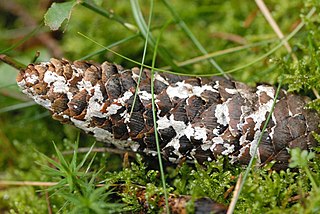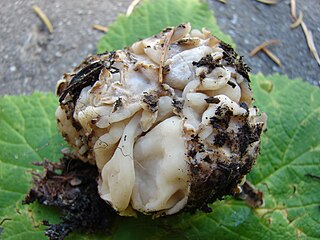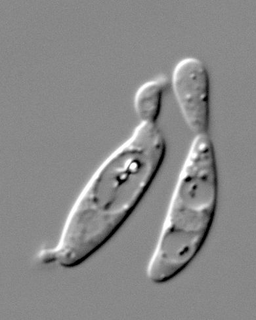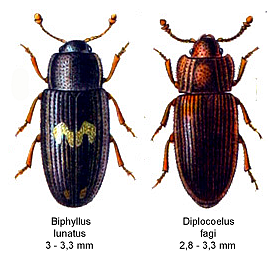
Nucleariida is a group of amoebae with filose pseudopods, known mostly from soils and freshwater. They are distinguished from the superficially similar vampyrellids mainly by having mitochondria with discoid cristae.

The Boletales are an order of Agaricomycetes containing over 1300 species with a diverse array of fruiting body types. The boletes are the best known members of this group, and until recently, the Boletales were thought to only contain boletes. The Boletales are now known to contain distinct groups of agarics, gasteromycetes, and other fruiting-body types.
Chytridiomycetes is a class of fungi. Members are found in soil, fresh water, and saline estuaries. They are first known from the Rhynie chert. It has recently been redefined to exclude the taxa Neocallimastigomycota and Monoblepharidomycetes, which are now a phylum and a sister-class respectively.

A least-concern species is a species that has been categorized by the International Union for Conservation of Nature (IUCN) as evaluated as not being a focus of species conservation. They do not qualify as threatened, near threatened, or conservation dependent.

The Agaricomycetes are a class of fungi in the division Basidiomycota. The taxon is roughly identical to that defined for the Homobasidiomycetes by Hibbett & Thorn, with the inclusion of Auriculariales and Sebacinales. It includes not only mushroom-forming fungi, but also most species placed in the deprecated taxa Gasteromycetes and Homobasidiomycetes. Within the subdivision Agaricomycotina, which already excludes the smut and rust fungi, the Agaricomycetes can be further defined by the exclusion of the classes Tremellomycetes and Dacrymycetes, which are generally considered to be jelly fungi. However, a few former "jelly fungi", such as Auricularia, are classified in the Agaricomycetes. According to a 2008 estimate, Agaricomycetes include 17 orders, 100 families, 1147 genera, and about 21000 species. Modern molecular phylogenetic analyses have been since used to help define several new orders in the Agaricomycetes: Amylocorticiales, Jaapiales, Stereopsidales, and Lepidostromatales.

Atheliaceae is a family of corticioid fungi placed under the monotypic order Atheliales. Both the order and the family were described by Walter Jülich in 1981. According to a 2008 estimate, the family contains 20 genera and approximately 100 species. However, many genera formerly considered to belong in the Atheliaceae have since been moved to other families, including Amylocorticiaceae, Albatrellaceae, and Hygrophoraceae. Despite being a relatively small group with inconspicuous forms, Atheliaceae members show great diversity in life strategies and are widespread in distribution. Additionally, being a group strictly composed of corticioid fungi, they may also provide insights on the evolution of fruiting body forms in basidiomycetes.

The Hymenochaetaceae are a family of fungi in the order Hymenochaetales. The family contains several species that are implicated in many diseases of broad-leaved and coniferous trees, causing heart rot, canker and root diseases, and also esca disease of grapevines. According to a standard reference text, the family contains 27 genera and 487 species.

Geopora is a genus of truffle-like fungi in the family Pyronemataceae, currently with 13 described species. The genus was circumscribed by mycologist Harvey Willson Harkness in 1885. Molecular phylogenetic reconstructions indicate that the cup-like apothecial Geopora should better be placed back in a separate genus, Sepultaria. Geopora would then only comprise Geopora cooperi and its close relatives.

Tremella is a genus of fungi in the family Tremellaceae. All Tremella species are parasites of other fungi and most produce anamorphic yeast states. Basidiocarps, when produced, are gelatinous and are colloquially classed among the "jelly fungi". Over 100 species of Tremella are currently recognized worldwide. Two species, Tremella fuciformis and Tremella aurantialba, are commercially cultivated for food.
Ammonia fungi are fungi that develop fruit bodies exclusively or relatively abundantly on soil that has had ammonia or other nitrogen-containing materials added. The nitrogen materials react as bases by themselves, or after decomposition. The addition of ammonia or urea causes numerous chemical and biological changes, for examples, the pH of soil litter is increased to 8–10; the high alkaline conditions interrupts the process of nutrient recycling. The mechanisms of colonization, establishment, and occurrence of fruiting bodies of ammonia fungi has been researched in the field and the laboratory.

The Microascales are an order of fungi in the class Sordariomycetes, subclass Hypocreomycetidae. This is a relatively small order of mostly saprobic fungi that live in soil, rotting vegetation and dung. Some species are plant pathogens, such as Ceratocystis fimbriata, transmitted by beetles to living trees and causing cacao wilt and many other economically important diseases. Species in the genus Pseudallescheria are pathogenic to humans, for example, Pseudallescheria boydii can cause allergic bronchopulmonary disease. The order was circumscribed in 1980.
Naïs is a genus of fungi in the family Halosphaeriaceae. The genus, which contains two species, was circumscribed by mycologist Jan Kohlmeyer in 1962 to contain Naïs inornata. N. aquatica was described from submerged wood collected in north Queensland, Australia in 1992.
Piromyces is a genus of fungi in the family Neocallimastigaceae.
Pseudonocardia is the type genus of the bacteria family Pseudonocardiaceae. Members of this genus have been found living mutualistically on the cuticle of the leafcutter ants because the bacteria has antibiotic properties that protect the fungus grown by the ants. When they are grooming, their legs are passed over their mouth gland that produces the antibiotic and then their legs touch the fungi while they are walking around. The ants have metapleural glands that produce the antimicrobial components to eliminate the Escovopsis fungi. The bacteria may also be found in crypts on the propleural plate. Pseudonocardia is found to have antibiotic properties provided to the leaf-cutter ant to inhibit the growth of Escovopsis, which is a black yeast that parasitizes the leaf-cutter ant. Pseudonocardia can be found in both aquatic and terrestrial ecosystems. Pseudonocardia can be referred to as a Actinobacteria. Most Actinobacteria grow in soils that are of a neutral pH. Actinobacteria are also important in plant-associated microbial communities are referred to as "free-living." This means that they are not dependent on another organism to live. For example: A non-free-living organism would be a parasite that depends on a host as a food source and a place for shelter. "Free-living" also allows these organisms to require less energy and food for survival. Pseudonocardia is a catalase-positive, non-motile, aerobic and a non-acid-fasting bacteria and produces a gram positive reaction. Under the microscope they exhibit branching, rod-shaped organisms.
There are many different strains of Pseudonocardia and a good portion of these strains have been found in China, in soils of the forest and in Eucalyptus trees of Australia.

The Microbotryomycetes are class of fungi in the Pucciniomycotina subdivision of the Basidiomycota. Until recently, the class contained four orders: the Heterogastridiales, the Leucosporidiales, the Microbotryales, and the Sporidiobolales, which contained a total of 4 families, 25 genera, and 208 species. The order Kriegeriales, containing two families, Kriegeriaceae and Camptobasidiaceae, was defined in 2012.

Biphyllidae or False Skin Beetles is a family of beetles, in the suborder Polyphaga. Worldwide, about 195 species are known. They live under the bark of dead trees and feed on fungi. It contains the following genera:

Tuber is a genus in the Tuberaceae family of fungi. It includes several species of truffles that are highly valued as delicacies.
Perkinsozoa is a proposed phylum of intracellular parasites in the superphylum Alveolata, which was suggested to account for the genus Perkinsus and other protist species that do not fit into existing Alveolata phyla.

Trichophyton terrestre is a fungus of the genus Trichophyton.












